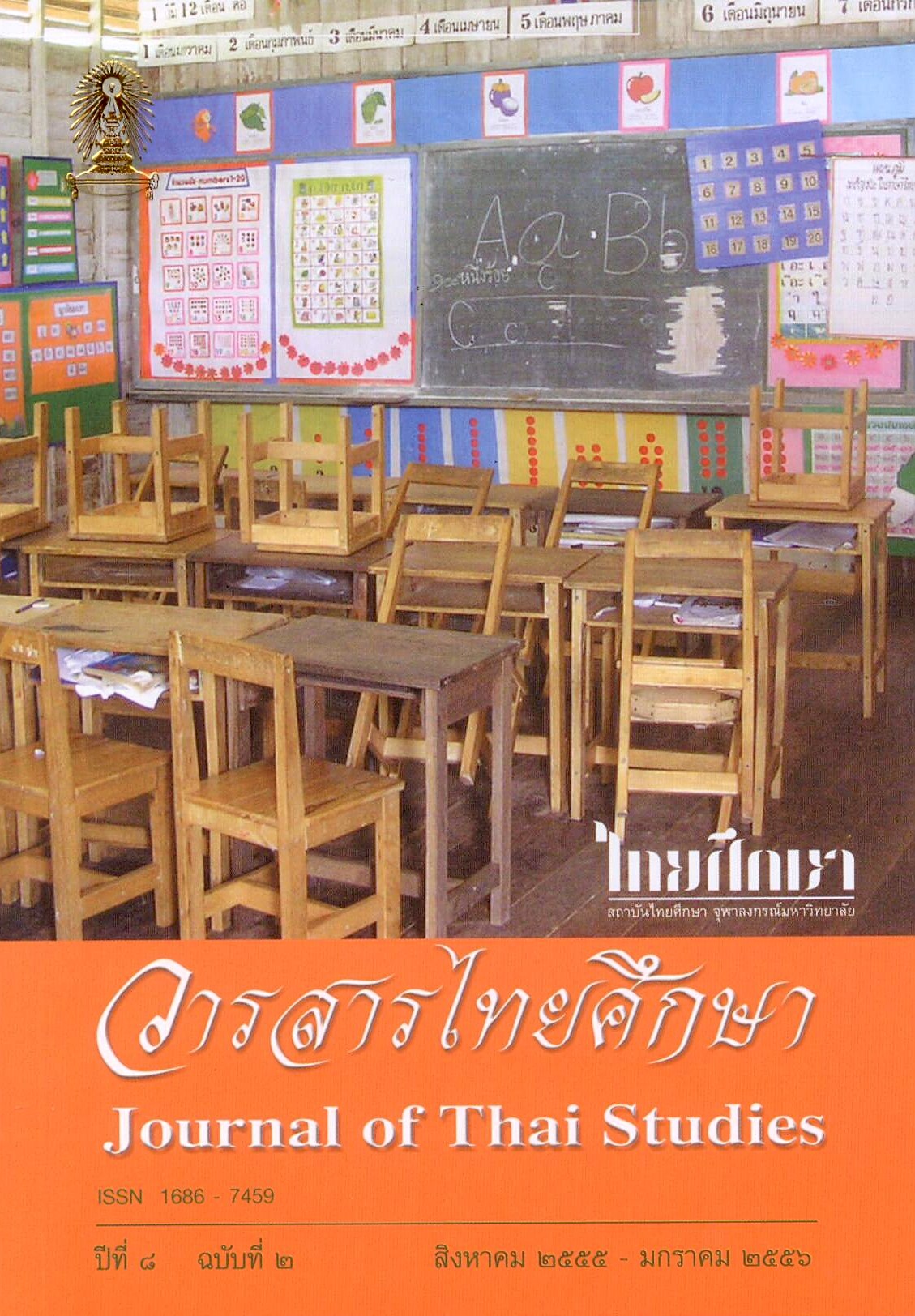Saensaeb Canal : History and Development
Main Article Content
Abstract
This research aims at studying the history of Saensaeb Canal, the first canal to be dug in the reign of King Rama III. The study focuses on the importance of the canal and the environmental, physical, social and cultural changes which have affected the role of the canal and the cultural dimension of the communities along the canal.
The research found that the need to carry military supplies during the long-lasting war between Thailand and Vietnam during the reign of King Rama III of the Rattanakosin period was the main reason for digging the Saensaeb Canal. After the war, the canal became a waterway artery on the east side of the Chao Phraya River when the city was extended along the canal.
The importance of the Saensaeb Canal increased after the signing of the Burney and Bowring Treaties when there was an increase in local and international trade in Thailand. Also, plantations, especially rice and sugar cane, were expanded for exports. The land on the banks of the Saensaeb Canal was used for agricultural purposes, worked by a large number of war captives who were Lao, Malay, Mon, Khmer, as well as by Chinese laborers who had settled in Thailand. These ethnic groups lived in their own communities, freely led their traditional ways of life, and peacefully co-existed along the canal.
As time went by, the Saensaeb Canal was developed and improved. The government provided appropriate administration for the people on both sides of the canal. To date, there are 18 districts under the Bangkok Metropolitan Administration along the canal. The Saensaeb Canal, which was dug almost 200 years ago, is one of the most important canals in the history of Thailand, although it is no longer one of the main waterways. However, the Saensaeb Canal is an alternative traff ic route for people in Bangkok and its suburbs and an interesting canal with a diverse cultural heritage.
Downloads
Article Details

This work is licensed under a Creative Commons Attribution-NonCommercial-NoDerivatives 4.0 International License.
Journal of Thai studies is licensed under a Creative Commons Attribution-Noncommercial-NoDerivatives4.0 Intenational (CC BY-NC-ND 4.0) licence, unless otherwise stated. Plese read our Policies page for more information on Open Access, copyright and permissions.
References
เอกสารชั้นต้น
สํานักจดหมายเหตุแห่งชาติ
จดหมายเหตุรัชกาลที่ ๓ เลขที่ ๑๐ จ.ศ. ๑๑๙๒ บัญชีเรื่องทํากําไรส่วยและเกณฑ์ร่อน
จดหมายเหตุรัชกาลที่ ๓ เลขที่ ๗ จ.ศ. ๑๑๙๕ ราชการทัพญวน เรื่องส่งข้าวสาร ๕๐ เกวียนไปพระราชทานกองทัพเจ้าพระยาบดินทร์
จดหมายเหตุรัชกาลที่ ๓ เลขที่ ๒๓ จ.ศ. ๑๒๐๐ บัญชีหมื่นสนิทสมบัติเรื่องจําหน่ายเงินค่านา
จดหมายเหตุรัชกาลที่ ๓ เลขที่ ๑๖ จ.ศ. ๑๒๐๒ ใบบอกฉะเชิงเทรา
จดหมายเหตุรัชกาลที่ ๓ เลขที่ ๑๖๒ จ.ศ. ๑๒๑๐ ร่างบัญชีหางว่าวหัวเมืองต่างๆ นําส่งเร่วส่วยรายวัน
จดหมายเหตุราชกิจรายวันรัชกาลที่ ๕ ภาค ๗ จ.ศ. ๑๒๔๐
จดหมายเหตุรัชกาลที่ ๕/๑ น. ๔๑, ๔/๑๑ รายงานพระอินทราธิบดีสีหราชรองเมืองถึงกรมหมื่นนเรศวรฤทธิ์เรื่องที่ดินทุ่งตะวันออก แขวงกรุงเทพฯ ซึ่งเกี่ยวข้องกับบริษัทขุดคลองแลคูนาสยาม ๕ มิถุนายน ๒๔๓๗
เอกสารชั้นรอง
หนังสือและวิทยานิพนธ์
กนกรัตน์ ยศไกร. “พลังชุมชนกับการรักษาคลองแสนแสบ” ภูมิปัญญากับการสร้างพลังชุมชน กรุงเทพฯ: ศูนย์มานุษยวิทยาสิรินธร (องค์การมหาชน), ๒๕๔๘.
กรรณิการ์ จุฑามาศ สุมาลี. ยะวา – ชวา ในบางกอก. กรุงเทพฯ: สํานักงานกองทุนสนับสนุนการวิจัย, ๒๕๔๑.
การศาสนา, กรม. ประวัติศาสตร์ทั่วราชอาณาจักร เล่ม ๒. กรุงเทพฯ: โรงพิมพ์การศาสนา, ๒๕๒๖.
จุลจอมเกล้าเจ้าอยู่หัว, พระบาทสมเด็จพระ. พระธรรมเทศนาเฉลิมพระเกียรติพระบาทสมเด็จพระนั่งเกล้าเจ้าอยู่หัว. ที่ระลึกงานพระราชทานเพลิงศพ นายกระเจิ่น สิงหเสนีณ วัดมกุฎกษัตริยาราม, ๒๕๓๗.
ทิพากรวงศ์, เจ้าพระยา. พระราชพงศาวดารกรุงรัตนโกสินทร์ รัชกาลที่ ๓. พระนคร: องค์การค้าคุรุสภา, ๒๕๐๔.
แน่งน้อย ศักดิ์ศรี, ม.ร.ว. และคณะ. องค์ประกอบทางกายภาพกรุงรัตนโกสินทร์. กรุงเทพฯ: โรงพิมพ์จุฬาลงกรณ์มหาวิทยาลัย, ๒๕๓๔.
บุญเตือน ศรีวรพจน์. คันฉ่องส่องวรรณคดี (เล่ม ๒). กรุงเทพฯ: บริษัททิปส์ พับบลิเกชั่น จํากัด, ๒๕๔๔.
ประชุมพงศาวดารฉบับหอสมุดแห่งชาติ เล่ม ๔. พระนคร: องค์การค้าคุรุสภา, ๒๕๐๗.
ประชุมพงศาวดารภาคที่ ๓๓. กรุงเทพฯ: องค์การค้าคุรุสภา, ๒๕๑๐.
วาสินี พงศ์ชินฤทธิ์. คุณภาพชีวิตของประชาชนสองฝั่งคลองแสนแสบ. วิทยานิพนธ์ปริญญาพัฒนบริหารศาสตรมหาบัณฑิต (พัฒนาสังคม) คณะพัฒนาสังคม สถาบันบัณฑิตพัฒนบริหารศาสตร์, ๒๕๔๐.
ศิลปากร, กรม. วัฒนธรรม พัฒนาการทางประวัติศาสตร์ เอกลักษณ์และภูมิปัญญาจังหวัดฉะเชิงเทรา. กรุงเทพฯ: โรงพิมพ์คุรุสภาลาดพร้าว, ๒๕๔๒.
สุนทรี อาสะไวย์. ประวัติคลองรังสิต : การพัฒนาที่ดินและผลกระทบต่อสังคม พ.ศ. ๒๔๓๑ - ๒๔๕๗. กรุงเทพฯ: สํานักพิมพ์มหาวิทยาลัยธรรมศาสตร์, ๒๕๓๐.
สุวิทย์ ธีรศาสวัต. ประวัติศาสตร์เศรษฐกิจการเมืองไทยตั้งแต่รัชสมัยสมเด็จพระเจ้าตากสินมหาราชถึงสมัยรัชกาลที่ ๓ (พ.ศ. ๒๓๑๐ – ๒๓๙๔). กรุงเทพฯ: สํานักงานคณะกรรมการวิจัยแห่งชาติ, ๒๕๒๕.
เสถียร ลายลักษณ์ และผู้อื่น. ประชุมกฎหมายประจําศก เล่ม ๕. พระนคร: โรงพิมพ์เดลิเมล์, ๒๔๗๘.
เสาวนีย์ จิตต์หมวด. กลุ่มชาติพันธุ์ : ชาวไทยมุสลิม. กรุงเทพฯ: กองทุนสง่า รุจิระอัมพร, ๒๕๓๑.


